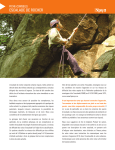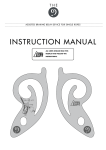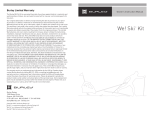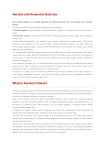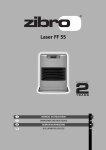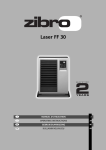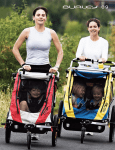Download safety guide
Transcript
u SAFETY GUIDE ICE CLIMBING Ice climbing involves certain risks. This activity takes place in natural environments, which are consequently far away from emergency services. This means major delays during incidents that require immediate care or evacuation. Make sure you have the skills and abilities and the appropriate equipment to climb this nationally renowned pillar of ice. The climber must be aware of the potential risks, including the possibility of material damages, injury and death. We advise you to read this document carefully. To plan your ice climbing excursion, find out about the approach walk conditions and the technical characteristics as related to weather conditions. You can get this information by calling the Fédération québécoise de la montagne et de l’escalade (FQME) at 514 252-3000, extension 3733, or by visiting www.fqme.qc.ca. It is important to note that during the approach walk, during the climb, and as you’re skiing or snowshoeing to the site or on the top of the cliff, you are responsible for your safety. There are no patrols on the climbing cliff or in the area. The participant is responsible for any expenses incurred during search and rescue operations (check ahead of time to find out if your insurance covers these risks). On the territory, the use of cell phones is limited due to the area’s isolation. We recommend bringing a satellite communication device. Caution! Your location and weather conditions could limit or even prevent the use of this communication tool. We suggest reading the leaflet Careful by Nature, available at our reception offices, and entrusting a friend or relative with a description of your project, including your destination, your itinerary and the time of your return, along with instructions to contact emergency services (911) in the event of your absence. To prevent false alarms, contact this person as soon as you get back. FORMALITIES CLOTHING Before leaving home, read at least one guide book describing the ice climbing wall. You must wear appropriate clothing. Keep some dry clothes handy for rest periods or for when you’re spotting your climbing partner. The first indicator of hypothermia is a chill that runs through the whole body. Pay attention! Dry clothes, a warm non-alcoholic beverage and food are good remedies. You must procure an access permit and a stay permit. Each member of the team must have taken a first aid course specifically for remote areas. You must also have mastered and practiced safety techniques, including self-rescue. Tips • When the temperature is close to freezing, waterproof clothing is essential to protect you from water. SAFETY AND COMMUNICATION • Favour the layered approach and avoid cotton clothing. You must behave in a way that will not endanger your own life or that of other participants. You must also demonstrate ethical behaviour towards the other climbers. • Avoid wearing undergarments with tight wrists or wearing tight socks. This can limit the blood circulation in your hands or feet. Make sure to bring emergency equipment and information on emergency measures in relation to the location of your ice wall. • Don’t tie your shoes too tight, since physical effort can make your feet swell and therefore more susceptible to getting cold. Tip • During the climb, participants must have a way of communicating with each other. The person who stays at the base camp must also be able to communicate with each member of the team during the climb. • Favour loose-fitting clothing that protects your lower back. • Fogged goggles are usually a good indicator of too much body heat or a sudden variation in body heat. If this happens, you can reduce your speed, the number of layers of clothing, or simply ventilate to let some cool air come in under your windbreaker. WHILE TRAVELLING WEATHER CONDITIONS Since it is often windy, there may be significant temperature variations on the same day. Weather conditions can change quickly from mild to severe. A change in the weather or your physical condition could lead to major changes in difficulty level or travel speed. Don’t confuse difficulty with danger. Be ready to retreat when faced with bad weather, injuries or other unexpected circumstances. Damp temperatures near the freezing point can lead to risks of hypothermia and death. Make sure to take the route that best suits your level of experience. Tips Tips • Before leaving home, it’s important to check the weather forecast for the area where you’ll be climbing. • Leave early, travel only during the day and travel only in a group (min. of 2 people). • Sun exposure can influence your comfort during the climb. Make sure to bring sun screen, sun glasses and enough drinking water. • Let your climbing partners or any other climbers know if you notice a piece of ice fall. • Check the sun exposure on the ice wall you have chosen. This will help you figure out what the ice texture will be like and what you should wear. FOOD PROTECTION OF THE ENVIRONMENT If you’re very careful about diet and hydration, it will be easier to maintain a comfortable body temperature. You’ll also have more Climbers must carry out all waste. This rule is in effect all along the trail and in the camping areas. energy for climbing and you’ll be more alert if you have to deal with the unexpected. Tips • Make sure your food and beverages for the climb are easily accessible. The forest environment must be preserved. Avoid cutting down or mutilating trees. During the approach walk and the climb, you’ll be travelling in the • Drink a minimum of two litres of water a day. natural habitat of many wildlife species. The animals are not particularly aggressive, but if you try to get too close to them, their survival instinct could translate into dangerous behaviour. • Eat and drink small quantities once an hour during your climb. Tips • There are several streams from which you can get water. Please note that their water quality has not been checked. For your safety, we recommend boiling or filtering the water. Sometimes water that seems good can contain harmful micro-organisms, which can cause gastrointestinal problems. • Avoid carrying unnecessary packaging that increases the volume and weight of your backpack or the baggage that will be transported by a motor vehicle. • Never consume or be under the effect of drugs or alcohol during the activity. TECHNICAL EQUIPMENT Use personal protective equipment approved by the International Mountaineering and Climbing Federation (UIAA) or the European Committee for Standardization. No matter what the brand, model or price of the technical equipment you carry with you, it is essential to be familiar with it. Tips • Wearing a helmet is recommended at all times. • A few days before your climb, simulate a departure by putting on your backpack filled with everything you’re planning to carry in it during the approach walk and the climb. This way you can check to see if it all fits into the pack and how much weight you’ll be carrying on your shoulders. You can then adjust your backpack or travel logistics according to your load. • Use biodegradable soap. • Leave the area in good condition after your stay (minimal impact). u SAFETY GUIDE COMPLEMENTARY INFORMATION HOW TO PREVENT… A Fracture, a dislocation or a sprain Leaving a Friend Alone in the Forest or on the Cliff • We suggest moving slowly, without taking big steps. It’s best to use a walking stick on rugged or slippery surfaces. If you get hurt despite these precautions, apply a cold compress and stabilize the injured part of the body. • We recommend leaving in groups of a minimum of three climbers (two climbers on the cliff and one at the base camp). If a problem arises despite this precaution, never abandon an injured person, except in the case of a force majeure. Put your energy into comforting the injured person and making a fire to signal your presence with smoke. Blisters • Don’t head out on a hike without having walked in your new shoes several times for at least fifteen minutes each time or without having done an easy climb in your new shoes. During the hike, keep your feet dry and protect areas prone to blisters with an elastic bandage. If you get a blister despite these precautions, apply a bandage to prevent it from bursting in order to keep the area sterile and give the skin time to heal. If the blister is punctured, disinfect the wound and cover it with antibiotic cream and a bandage Ophthalmia • Wear sunglasses with adequate UV protection, even when the sky is grey. Despite this precaution, if it happens, keep your eyes in darkness. Mild or Serious Wounds • It is always recommended to wear loose-fitting clothing and to adjust your backpack before leaving. You must also always handle your equipment safely, such as ices axes, ice screws, knives, axes or camp stoves. Move slowly. If you get hurt despite these precautions, disinfect the wound with an antiseptic and cover it with a bandage. Serious wounds must be protected from infection by covering them with sterile gauze and seeking medical attention. • One person must remain at the foot of the cliff to take care of logistics in case of an accident. Keeping a line of communication open between each climber and the person at the base camp should be easy to do. WHAT TO DO IF YOU’RE LOST During the approach walk, if you’re not sure of your location, stay calm, stop and take a few minutes to review the situation. Then return to a place that’s easy to identify on the map: road and stream intersections, bridges, buildings or signs. Review the situation again. If you are lost, stay in place and wait for help. If you are absolutely sure of how to find your way, make the decision to keep going or turn back and retrace your steps. Caution! Off the trails, hikers always tend to overestimate their speed. It rarely exceeds 2 km/h. u WHAT TO BRING FORMALITIES CLOTHING Stay permit Pants and jacket (external shell) Access permit Gloves SAFETY AND COMMUNICATION Functional clothing (favour synthetic and multi-layer) Communication device (satellite phone) Hats Shoes for the camp Sound signalling device (whistle) Device for communication between climbers and the person who stays at the foot of the cliff TECHNICAL EQUIPMENT Helmet A sufficient amount of food Climbing equipment approved by the International Mountaineering and Climbing Federation (UIAA) or the European Committee for Standardization Water filter Sun glasses Canteen for drinking water First aid kit Thermos for hot liquid Sun screen Camp stove and fuel (naphtha recommended) Waterproof matches Utensils and mess kit Multipurpose knife FOOD Survival kit TRAVEL Backpack Topographical map specific to your itinerary (in a waterproof case) Personal items (toilet paper) GPS, spare batteries, user’s manual Compass with magnetic variation of the region visited Flashlight or headlamp and batteries ENVIRONMENT Biodegradable soap Bags for carrying out garbage







